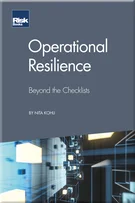Too many cooks in the kitchen: mastering the art of managing CECL volatility
Cristian deRitis and Christopher Stanley
Introduction
An overview of CECL: setting the context
Outlining the most impactful assumptions and challenges under CECL: an auditor’s view
Outlining the most impactful assumptions and challenges under CECL: a banker’s view
A banking industry perspective on key CECL decisions
Challenges and solutions for wholesale portfolios
Challenges and solutions for retail mortgage portfolios
Challenges and solutions for retail credit card portfolios
Challenges and solutions for student loans
Challenges and solutions for securities portfolios
The evolution of purchased loan accounting: from FAS 91 to the CECL transition
Challenges and solutions for qualitative allowance
Challenges and solutions: an auditor’s point of view
Early view of CECL integration into stress testing: practical approaches
Too many cooks in the kitchen: mastering the art of managing CECL volatility
Beyond CECL: rethinking bank transformation
Data collision: efficient lending under CECL
Cutting through the hype: how CECL is impacting investor views of procyclicality, credit analysis and M&A
Concentration risk: the CECL magnifying glass
Closing thoughts
“Once you have mastered a technique, you hardly need to look at a recipe again and can take off on your own” Julia Child
Regardless of their CECL adoption status, all reserve managers can expect questions about volatility. In the pre-adoption phase of CECL preparation, volatility discussions commonly emphasised the correct root causes, but too often compelled reserve managers with a formulaic approach. Great chefs master fundamentals, not recipes. To remix their CECL menu, or improvise when confronted with volatility, filers will need to think more like a chef than a home cook. Economic forecasting and credit modelling fundamentals provide a discussion guide for model developers, credit risk and financial planning professionals to agree on objectives and adapt when the unexpected forces a change of recipe.
This chapter is organised using the primary drivers of volatility, and includes prompts for thoughtful consideration of fundamentals — not formulas — by CECL stakeholders. We explore the causes, consequences and processes that filers may adopt to measure and mitigate volatility while still achieving the standard’s requirement of producing a “reasonable and supportable”
Copyright Infopro Digital Limited. All rights reserved.
As outlined in our terms and conditions, https://www.infopro-digital.com/terms-and-conditions/subscriptions/ (point 2.4), printing is limited to a single copy.
If you would like to purchase additional rights please email info@risk.net
Copyright Infopro Digital Limited. All rights reserved.
You may share this content using our article tools. As outlined in our terms and conditions, https://www.infopro-digital.com/terms-and-conditions/subscriptions/ (clause 2.4), an Authorised User may only make one copy of the materials for their own personal use. You must also comply with the restrictions in clause 2.5.
If you would like to purchase additional rights please email info@risk.net










